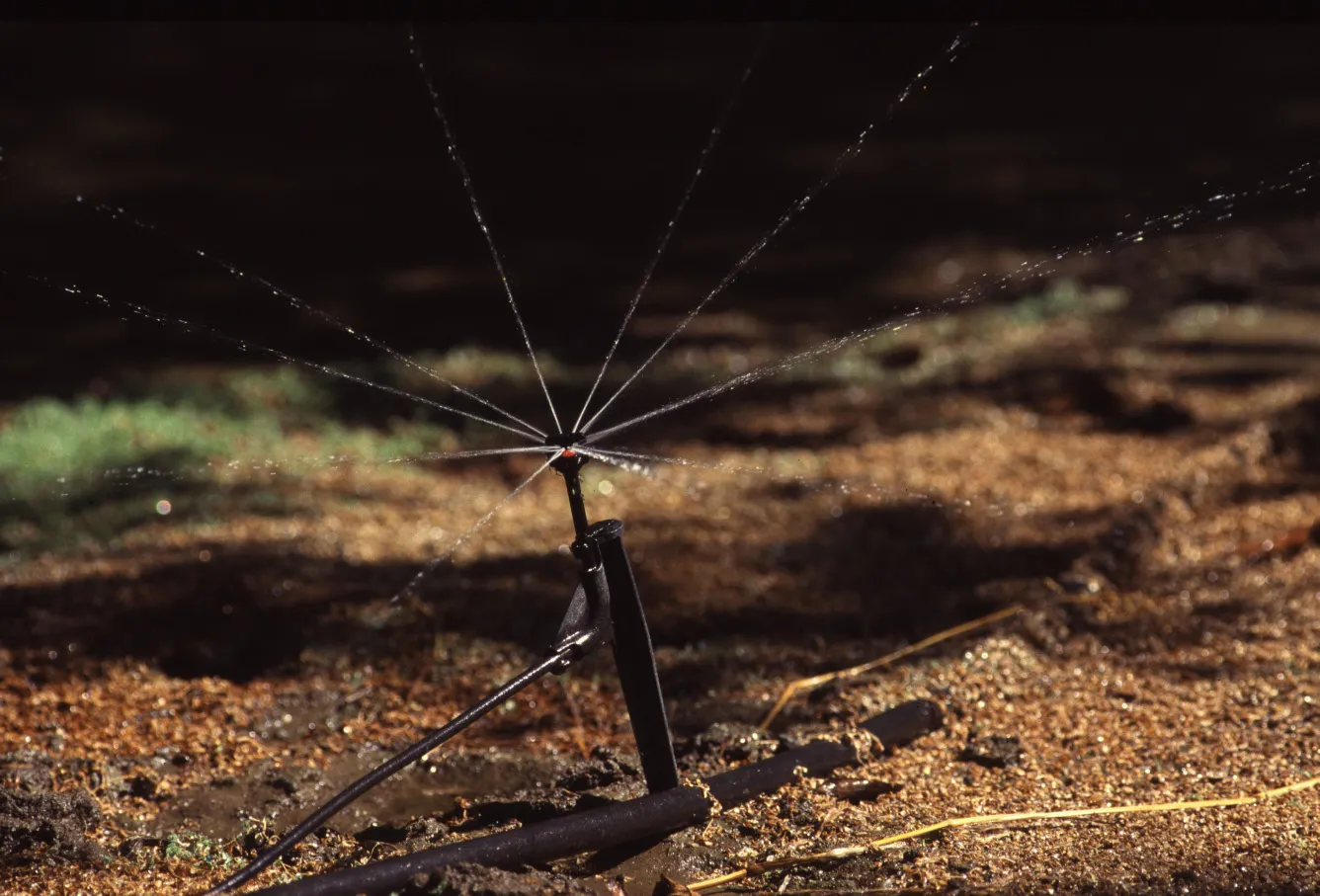Microsprinkler Distribution Uniformity Measures

Some microsprinkler discharge variability may exhibit patterns that can be explained. For example, (1) elevation changes may explain increases or decreases in discharge rates, (2) microsprinklers farther from the head of the system often are at a lower pressure due to friction losses, and (3) microsprinklers farther along a lateral line may be at a lower pressure than those at the head of the lateral line, again due to frictional pressure losses.
A significant decrease in microsprinkler discharge rates at the tail end of lateral lines may indicate a clogging problem caused by a lack of system flushing. Silt and clay particles often settle at the tail end of lateral lines and unless they are flushed out of the system, they can clog microsprinklers.
Microsprinklers discharge variability throughout the system that appears to be random can be caused by:
- Manufacturing variability. There are always slight variations in discharge rate between one emission device and the next due to manufacturing differences. For quality equipment, this variability will be small and is difficult even to measure in a field installation.
- Biological, particulate, and chemical precipitates. Emission device clogging will often appear in a random pattern. Biological, particulate, and chemical precipitate clogging all occur in a random pattern. One emitter or microsprinkler may show a reduced discharge rate due to clogging while an adjacent emission device will show no such evidence.
Distribution Uniformity (DU)
Discharge uniformity measures the variability of microsprinkler discharge rates. There are a number of terms used to quantify the discharge variability but the most commonly used is Distribution Uniformity (DU). Design Emission Uniformity (EU) is sometimes used to quantify microirrigation uniformity. The numerical uniformity value of EU and DU is the same.
When used as part of a microirrigation system evaluation process, DU is defined as:
|
Distribution Uniformity DU - % |
= | Average of low quarter discharge rates | ÷ | Average of all discharge rates | x | 100 |
The average of the low quarter discharge rates is determined by ranking all the measured discharge rates, from lowest to highest, and averaging the lower 25% of discharge rates. For example, if 40 microsprinklers were measured, you would rank them lowest to highest, and then average the discharges of the 10 microsprinklers with the lowest discharge rates. That would be the average of the low quarter discharge rate.
For a new microirrigation system, the following table lists the recommended ranges of EU for various systems. EU is often used to describe the design uniformity of a new microirrigation system while DU is frequently used to measure the uniformity of a field-evaluated microirrigation systems.
Table 1. Recommended ranges of design emission uniformity (EU).
| Emitter type | Spacing (m) | Topography | Slope, % | EU range, % |
|---|---|---|---|---|
| Point source on perennial crops | > 4 | uniform steep or undulating |
< 2 > 2 |
90 to 95 85 to 90 |
| Point source on perennial or semi-permanent crops | < 4 | uniform steep or undulating |
< 2 > 2 |
85 to 90 80 to 90 |
| Line source on annual or perennial crops | All | uniform steep or undulating |
< 2 > 2 |
80 to 90 70 to 85 |
Source: ASABE EP405 Standard. February, 2003.
Due to wear on emitters, clogging, and leaks, the DU value for a microirrigation system often decreases with time. Good maintenance should minimize this decline.
If you have a previous evaluation(s) to compare to, a DU decline of 5% or more is an indicator that a problem such as clogging is occurring. A corresponding decline in average application rate would also be further evidence of clogging.
If this is the first evaluation of the microsprinkler system and the DU value is substantially below the recommended ranges in Table 1 above, determining the cause of the variability should be a 2-step process.
- Examine the pressure measurements gathered during the evaluation. Significant variability in pressures within the system will lead to emission discharge variability unless pressure compensating (PC) microsprinklers are used. Determining what to do to mitigate excessive pressure variability should be discussed with an irrigation professional, most properly a qualified microirrigation system designer.
- If pressure measurements show relatively consistent operating pressure within the system, then the emitter discharge variability is likely due to clogging of emitters. For information on solving the problem, go to “I have a Clogging Problem and I Want to Solve It”.
For an distribution uniformity example, click below.
Surface Drip Tubing Systems
Microsprinkler Systems
